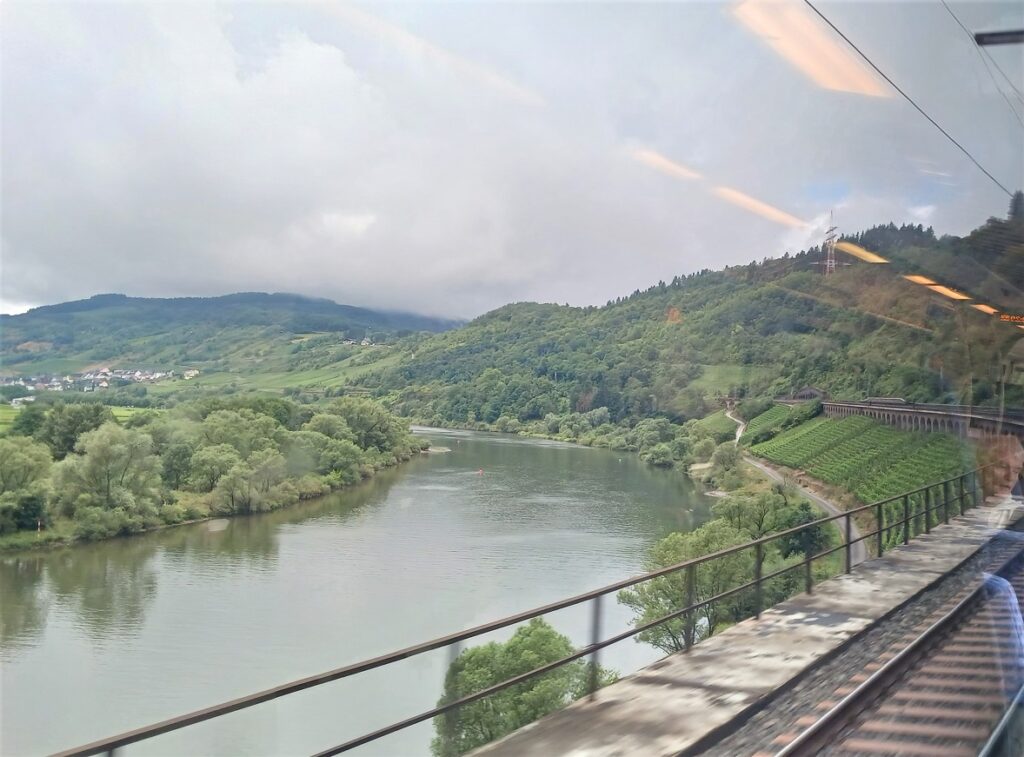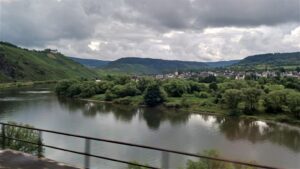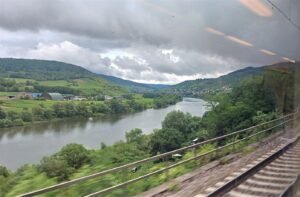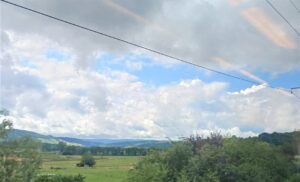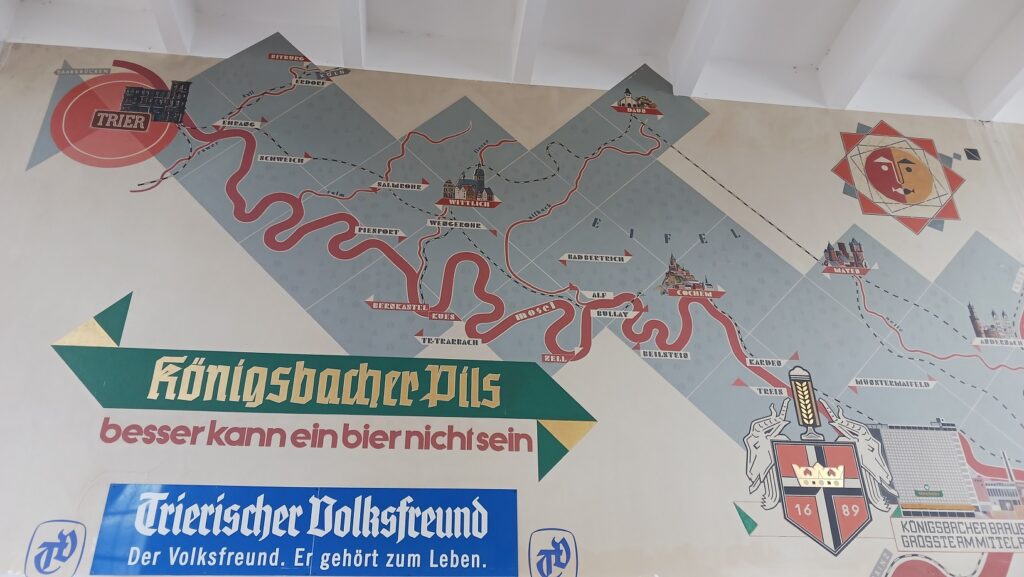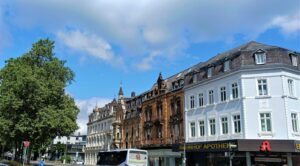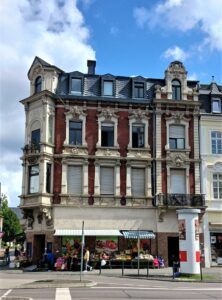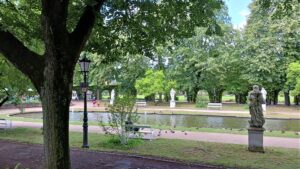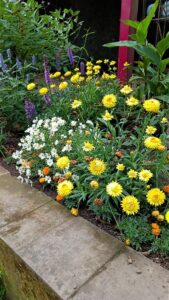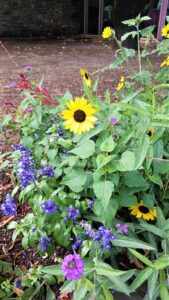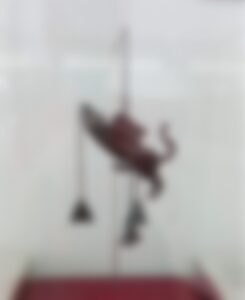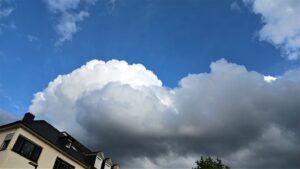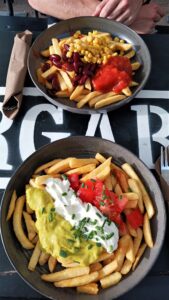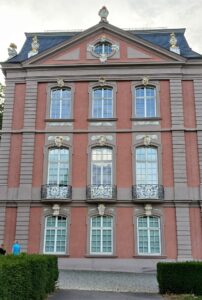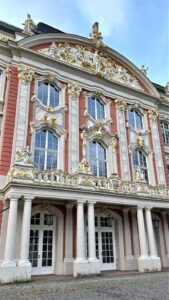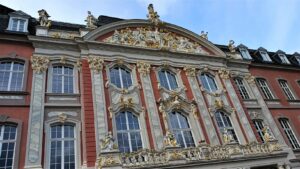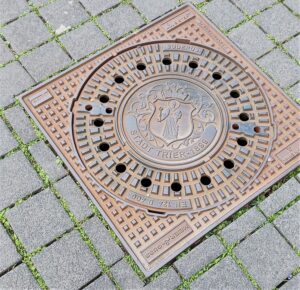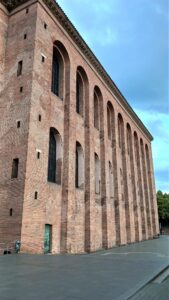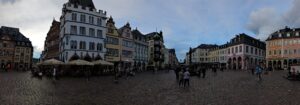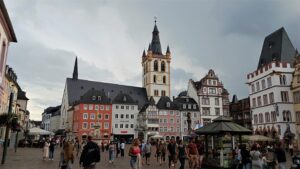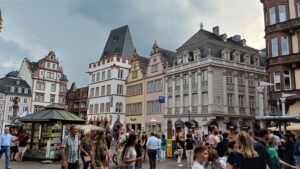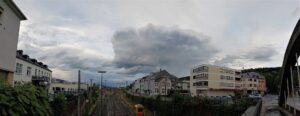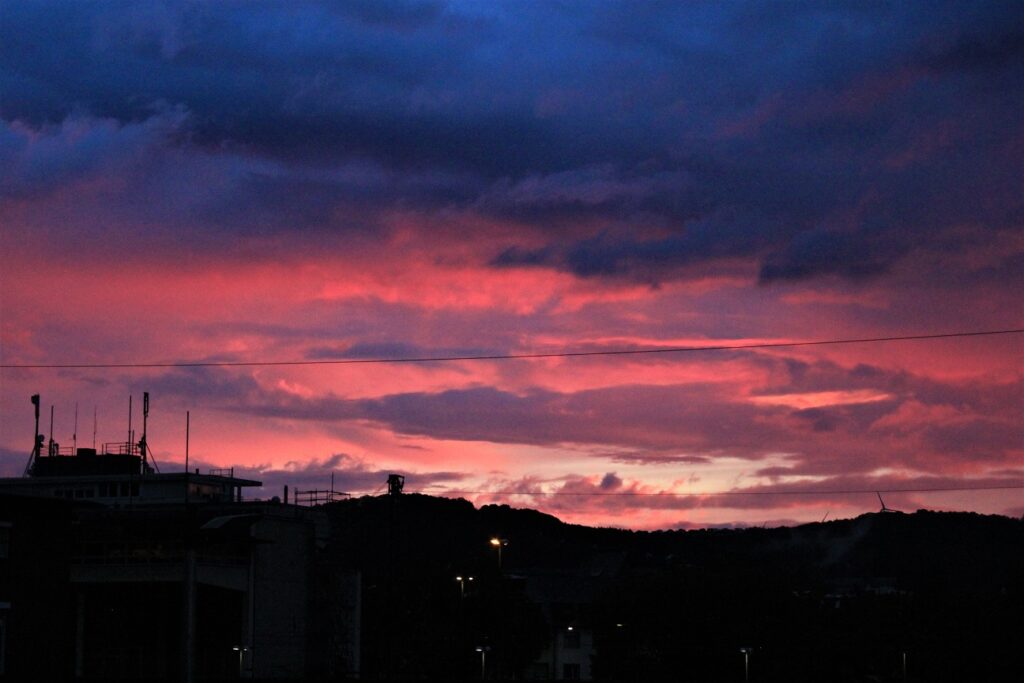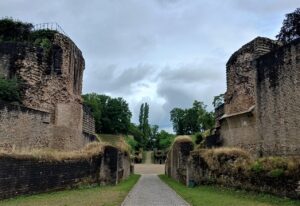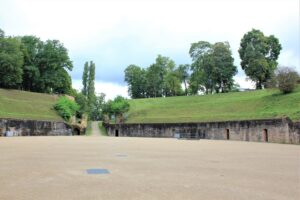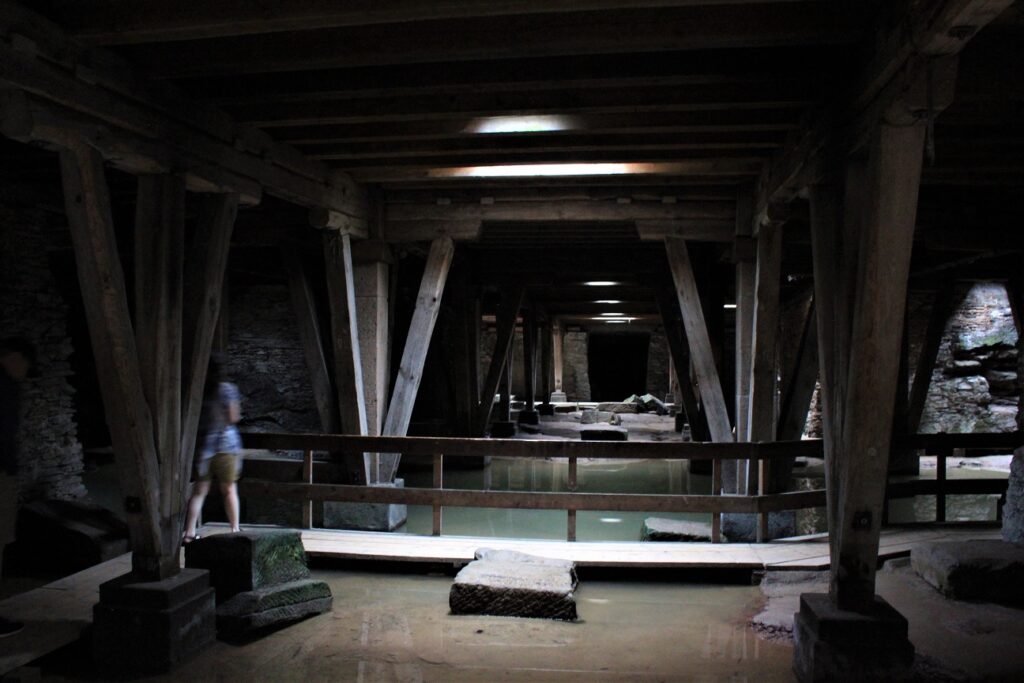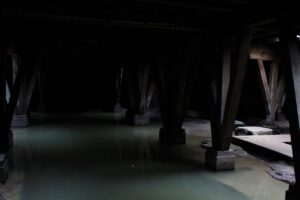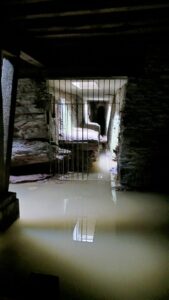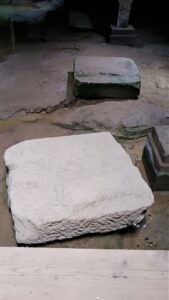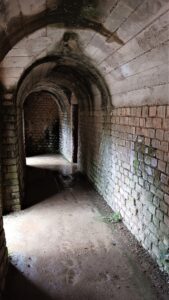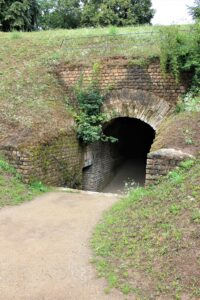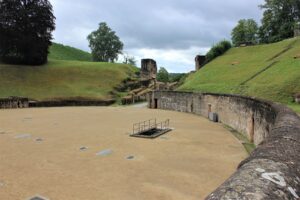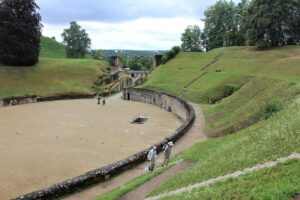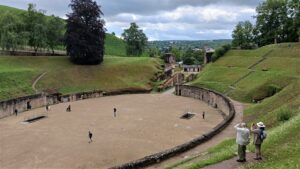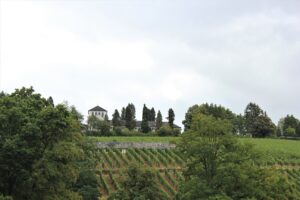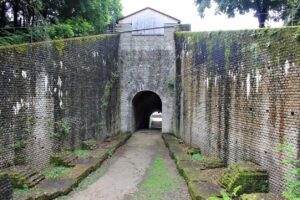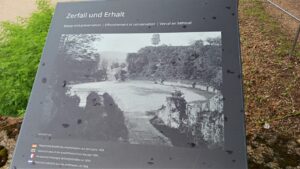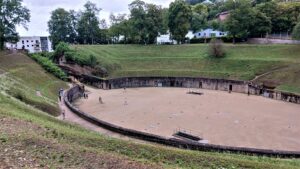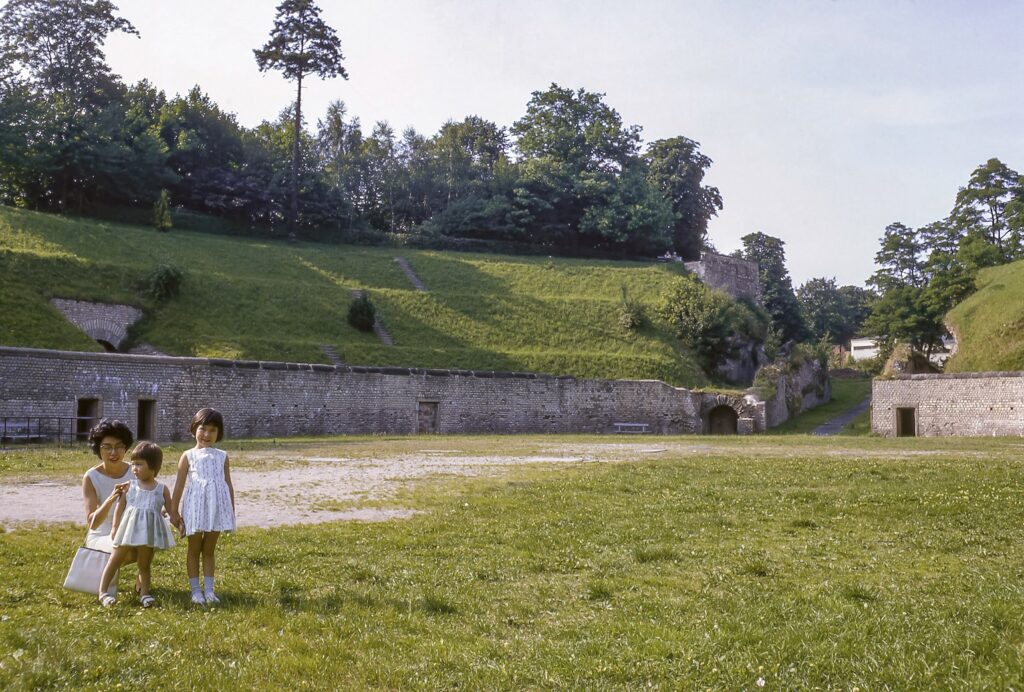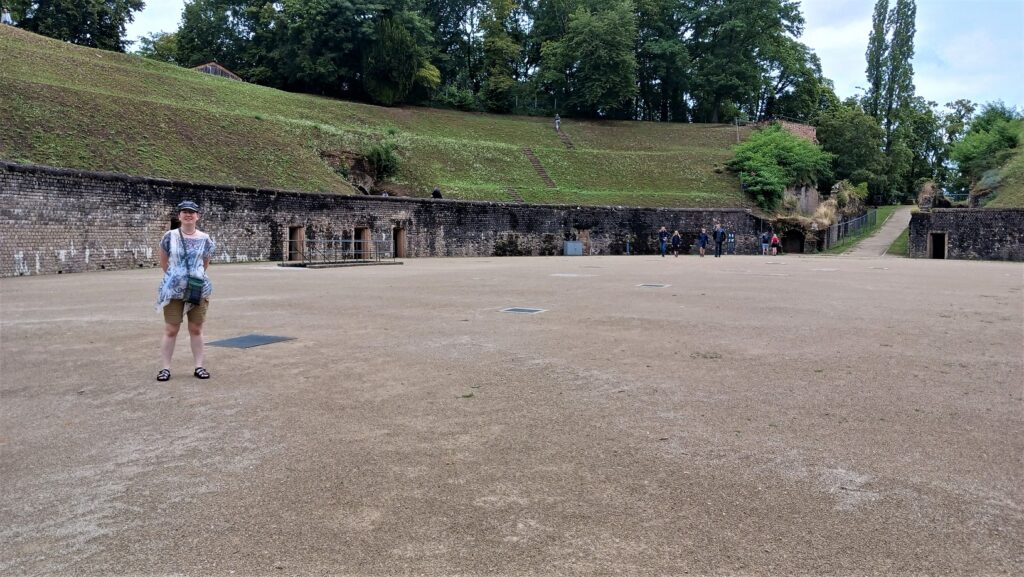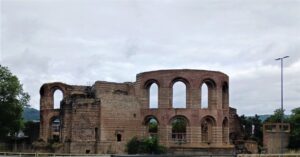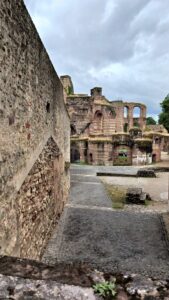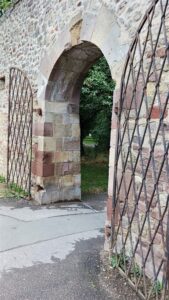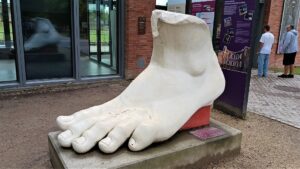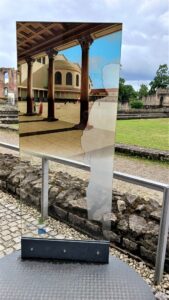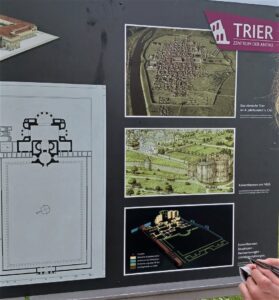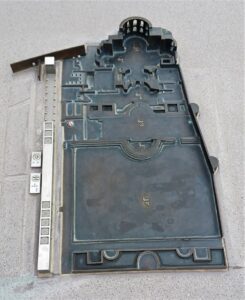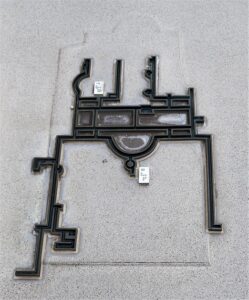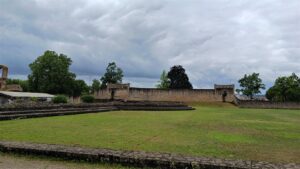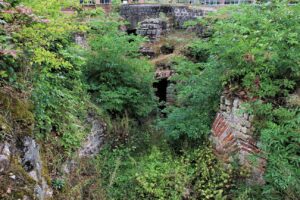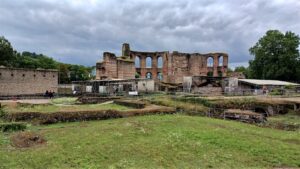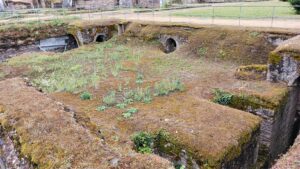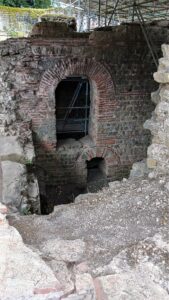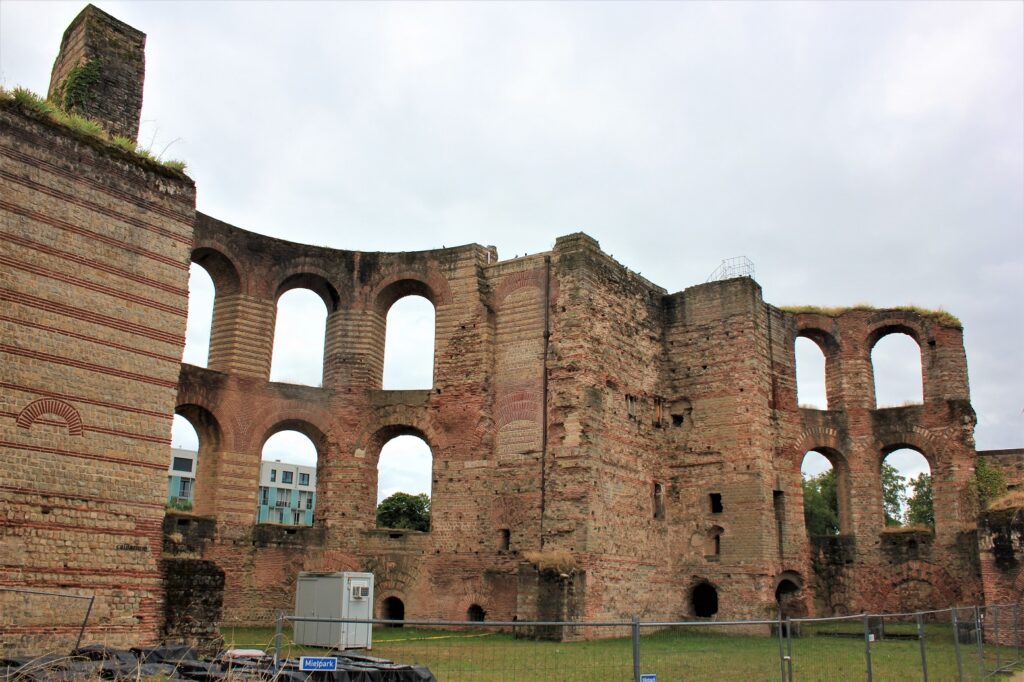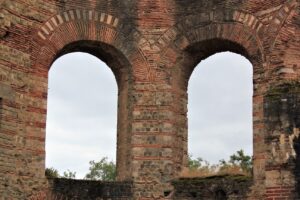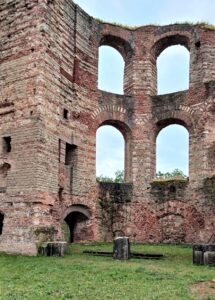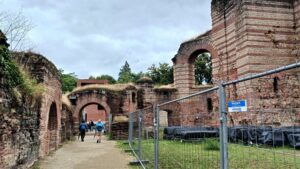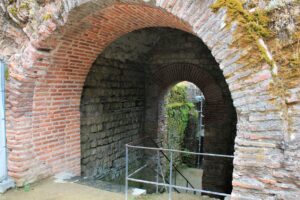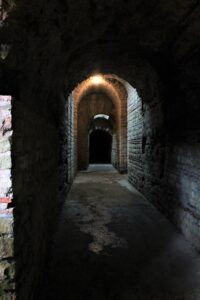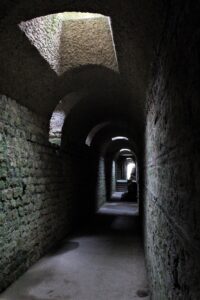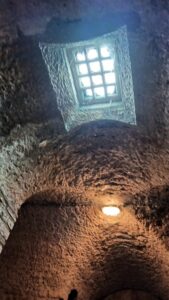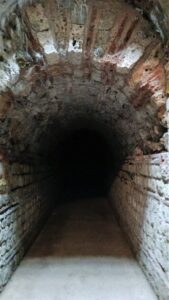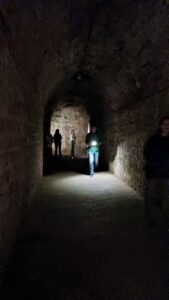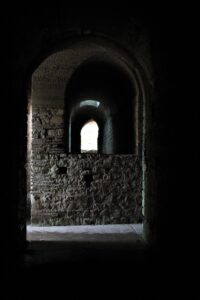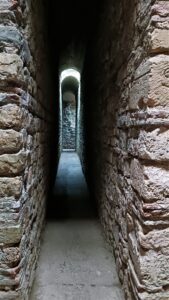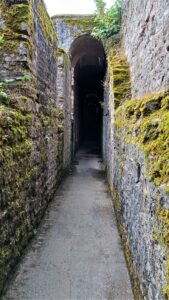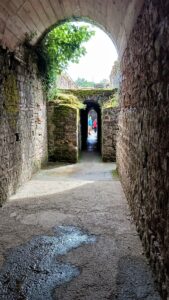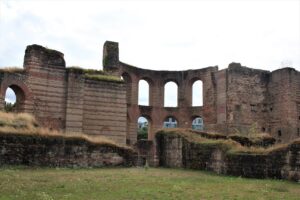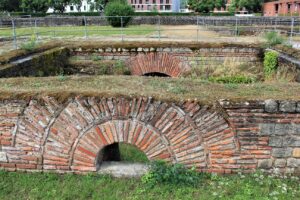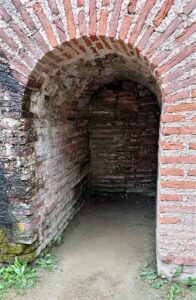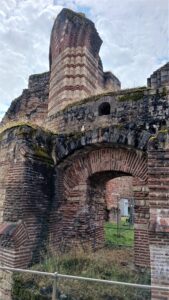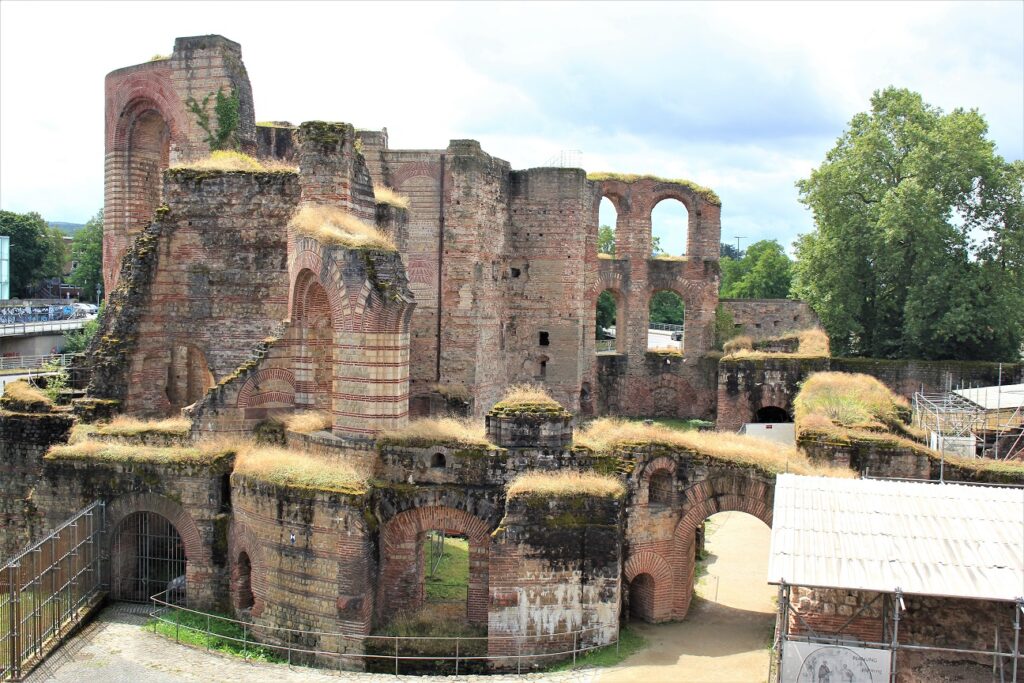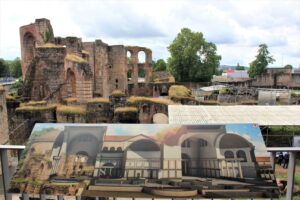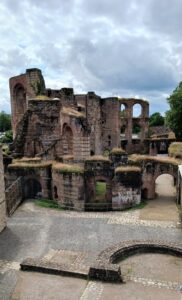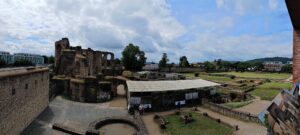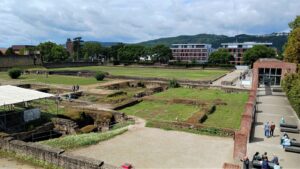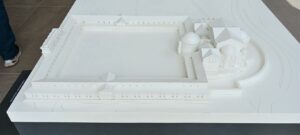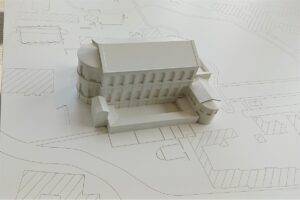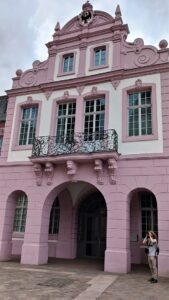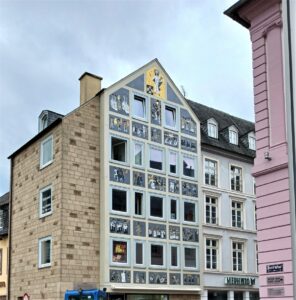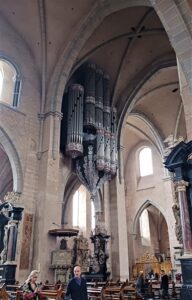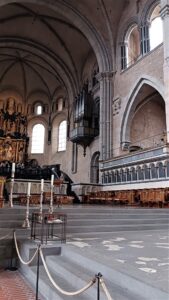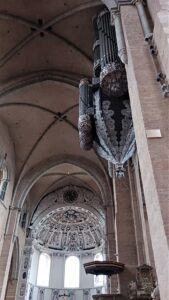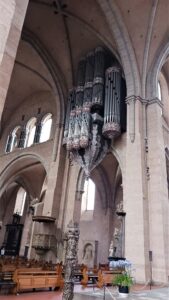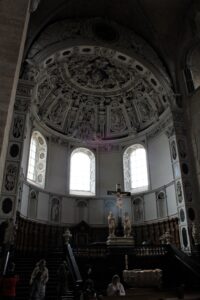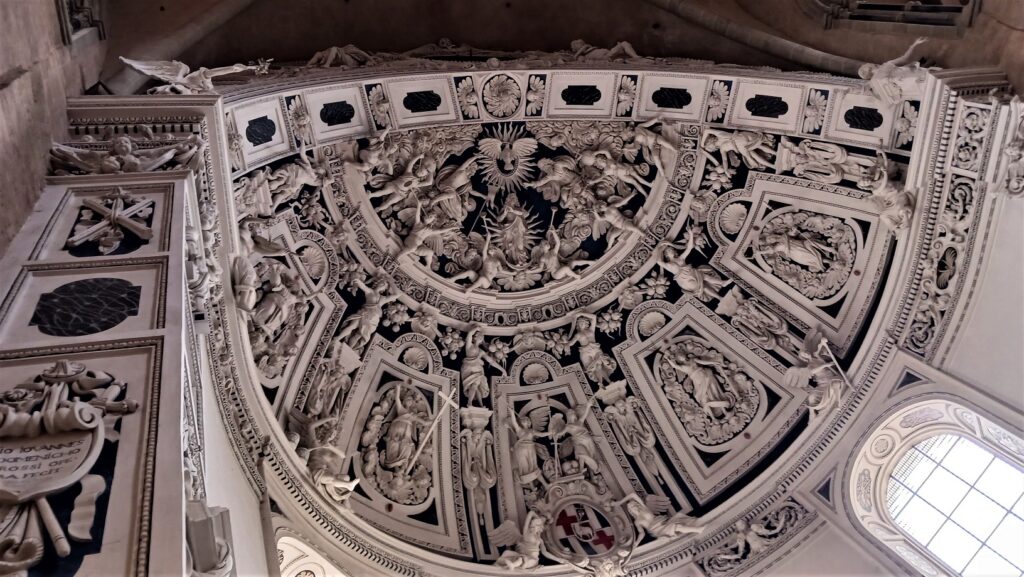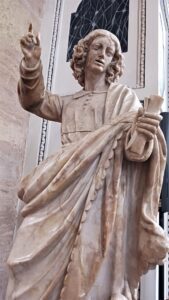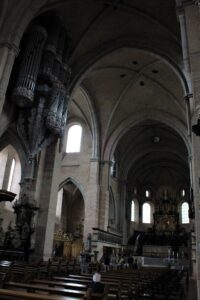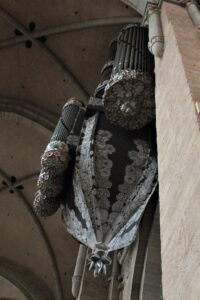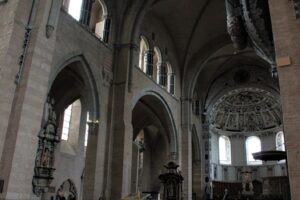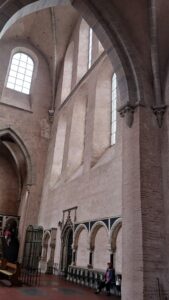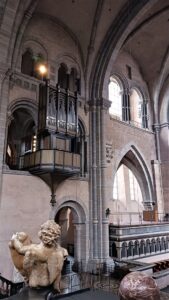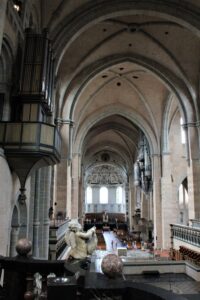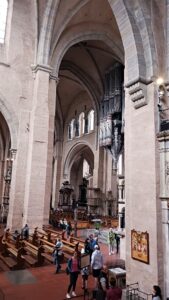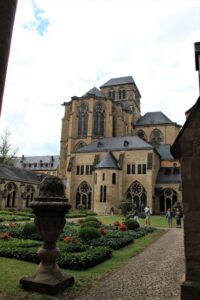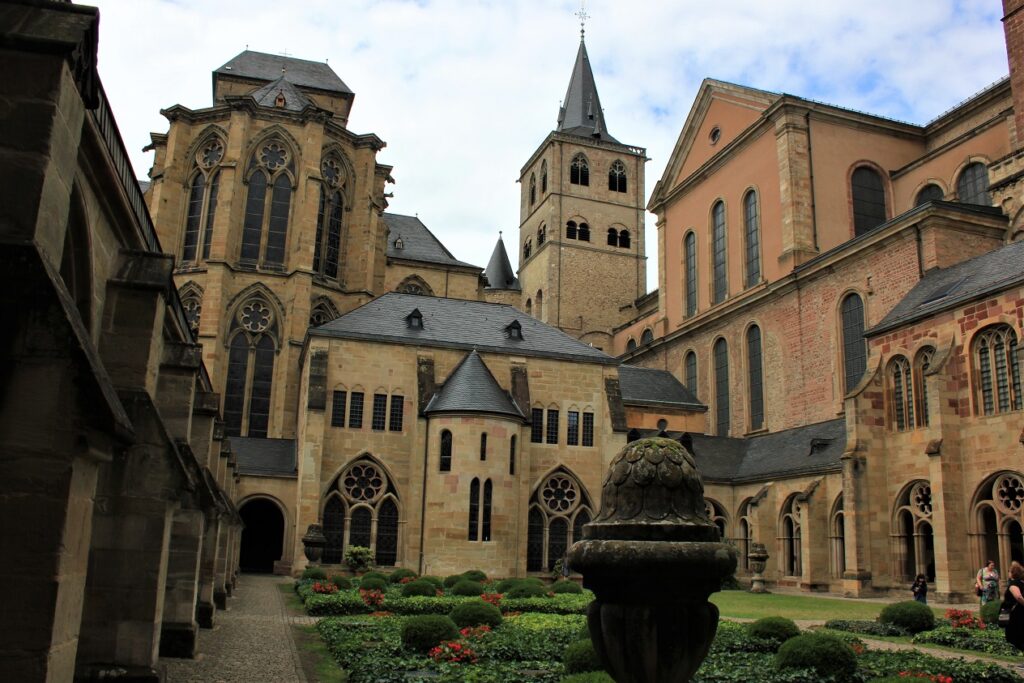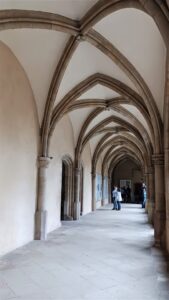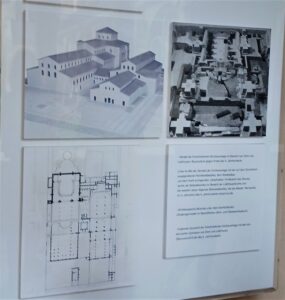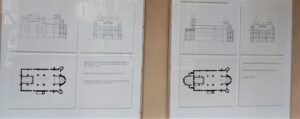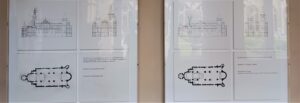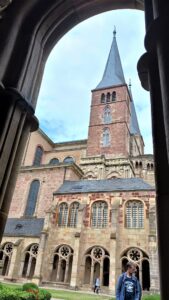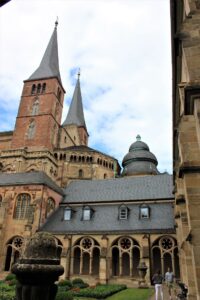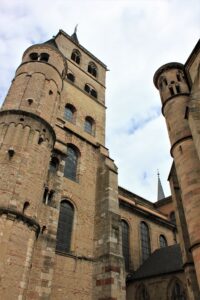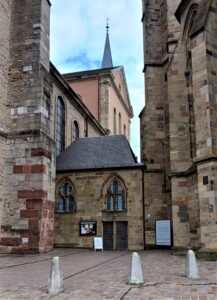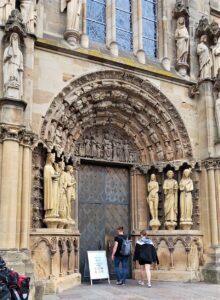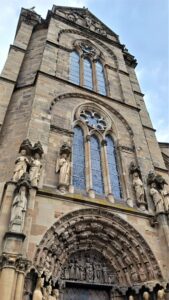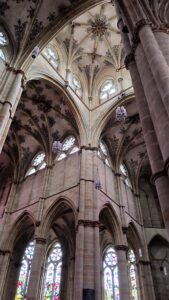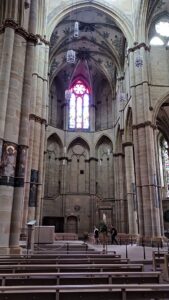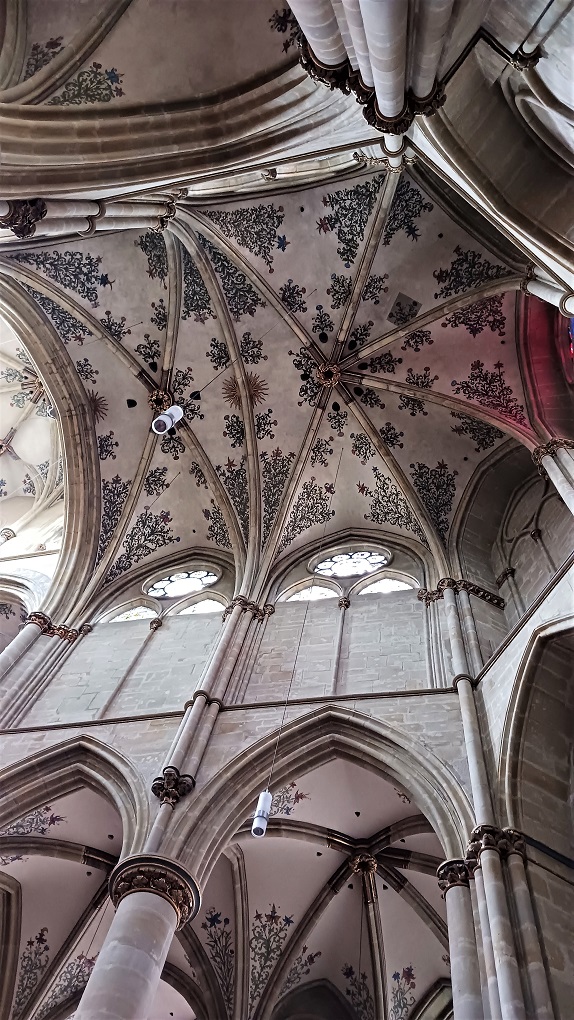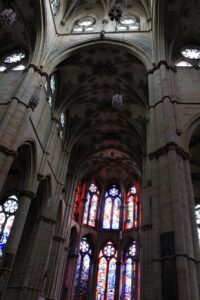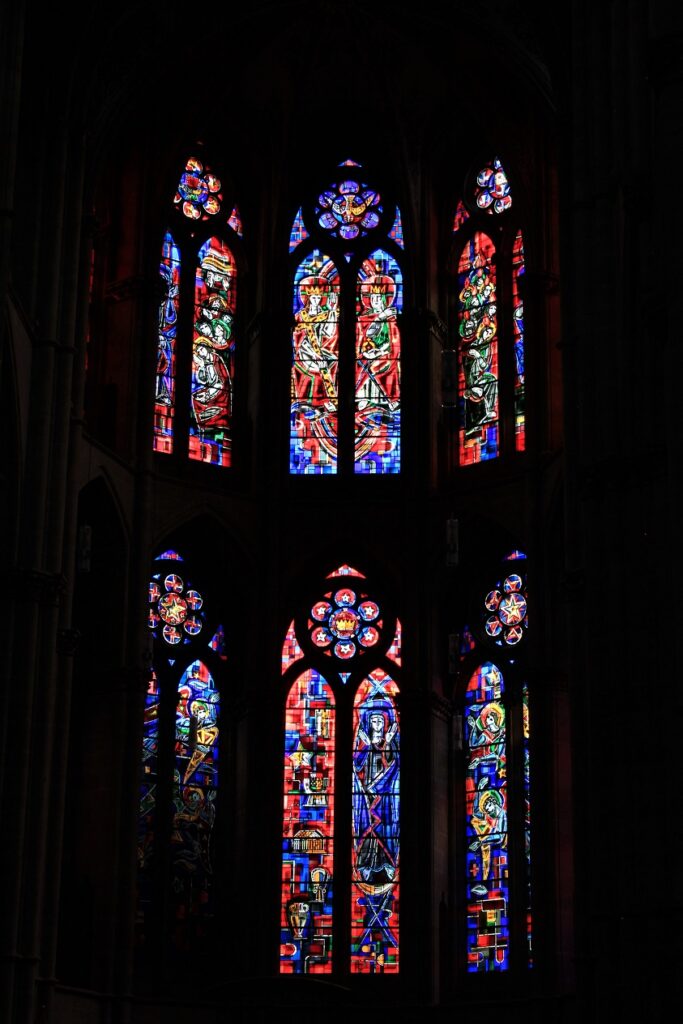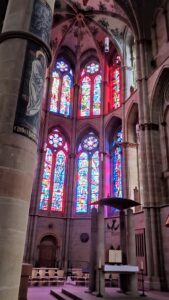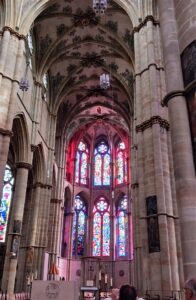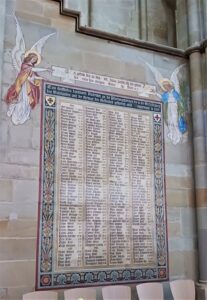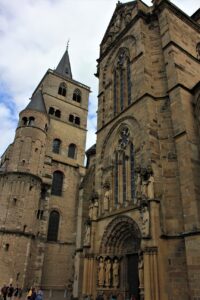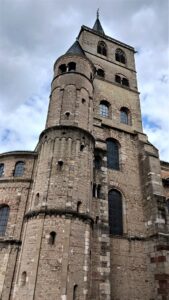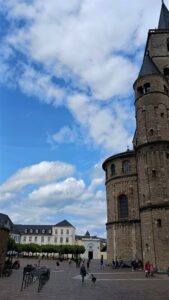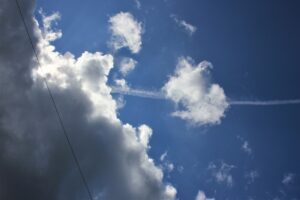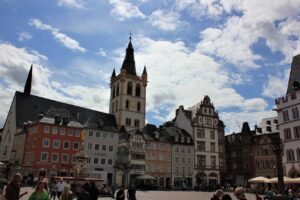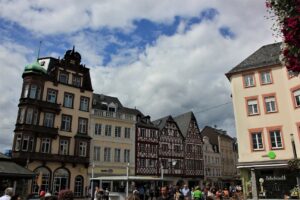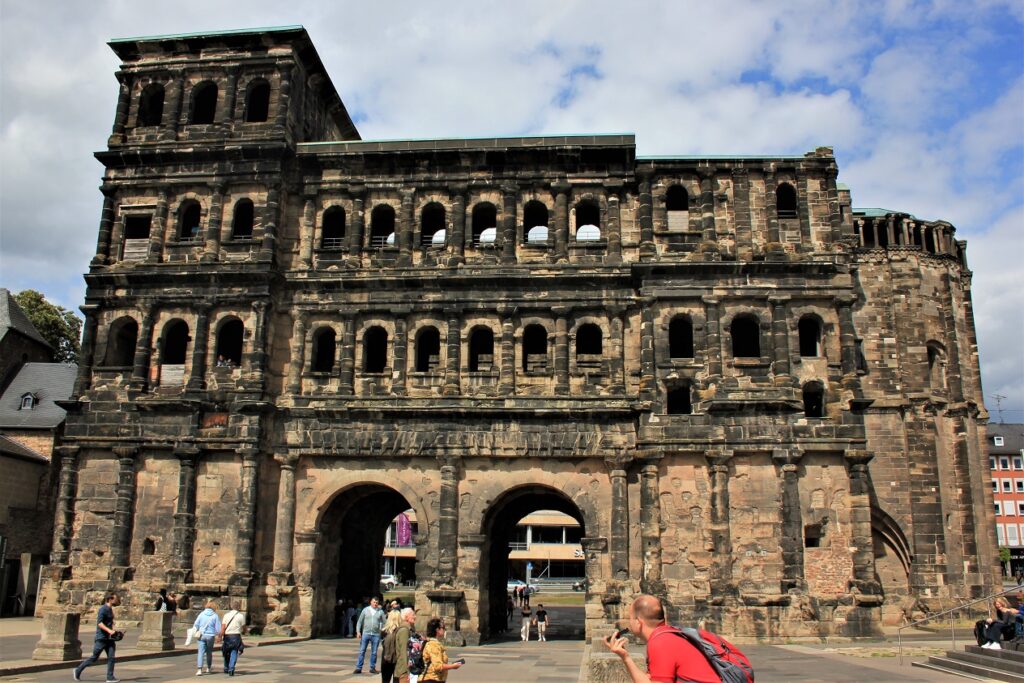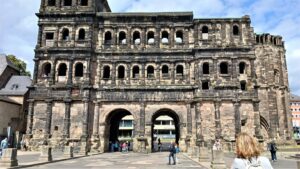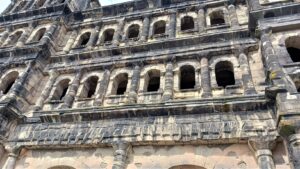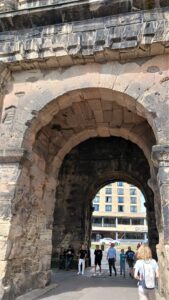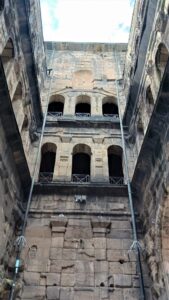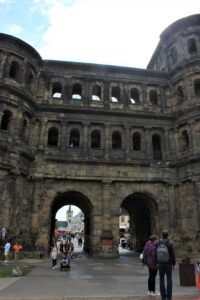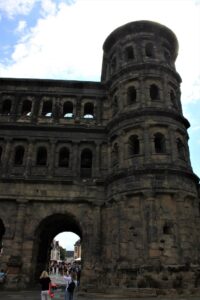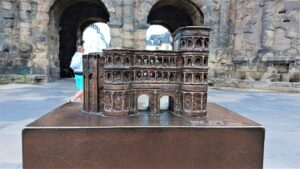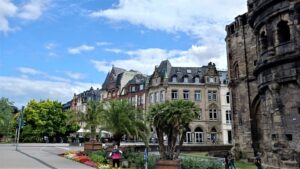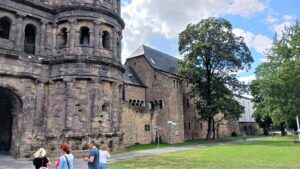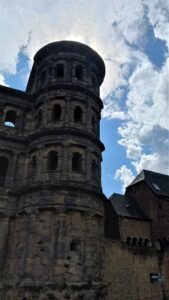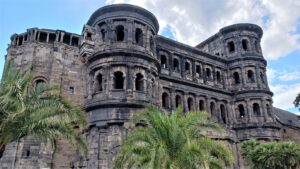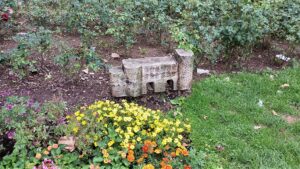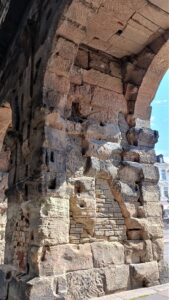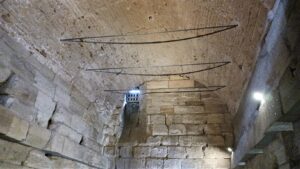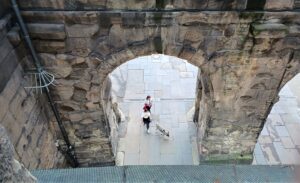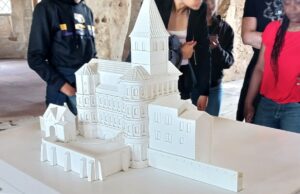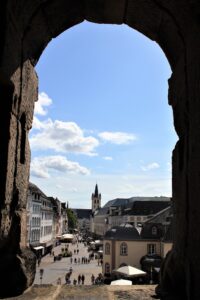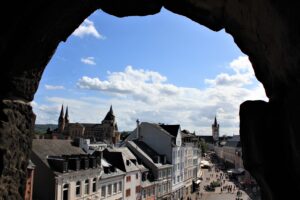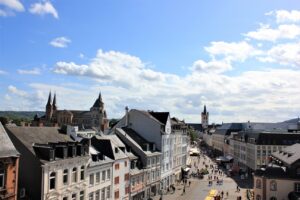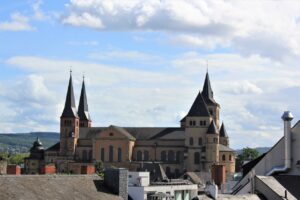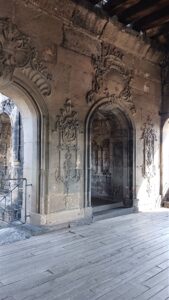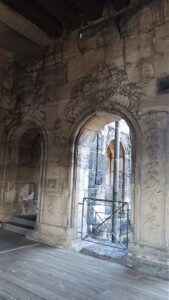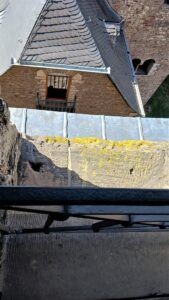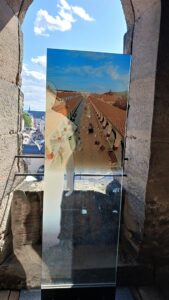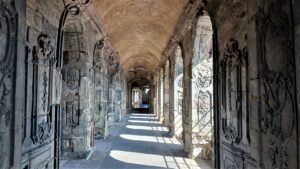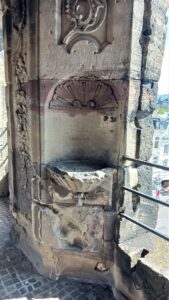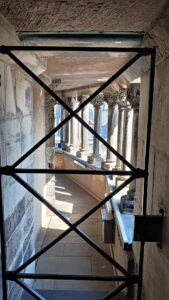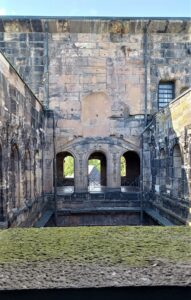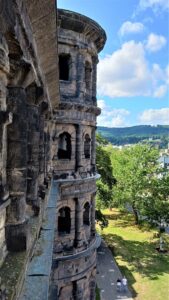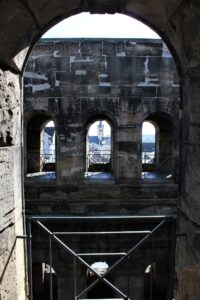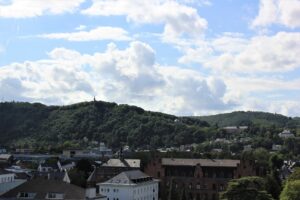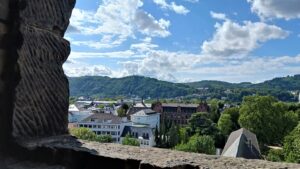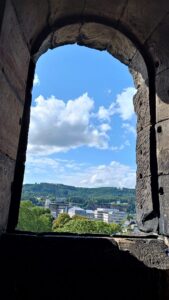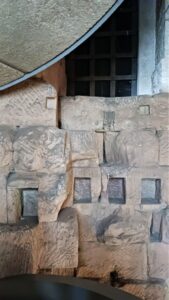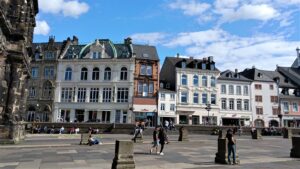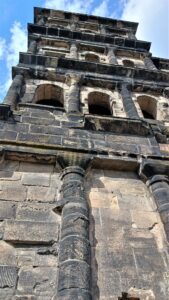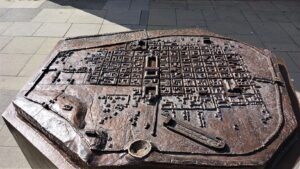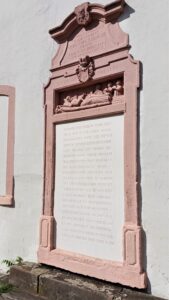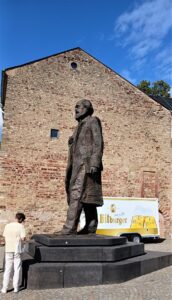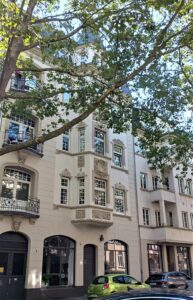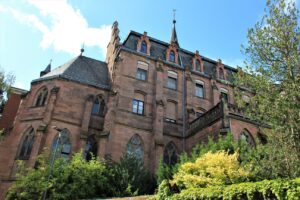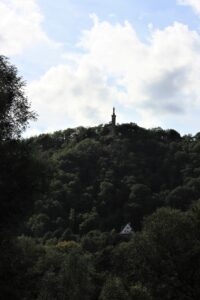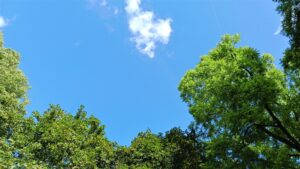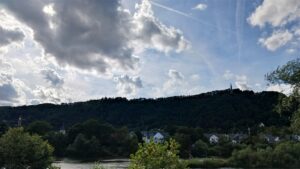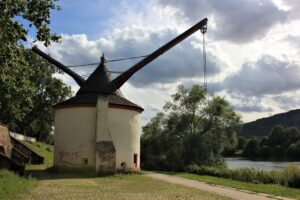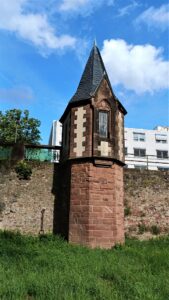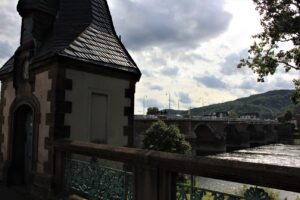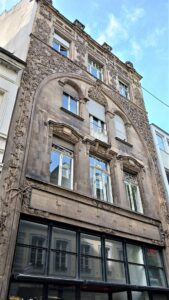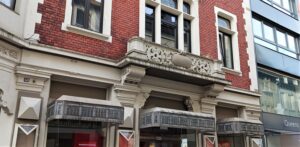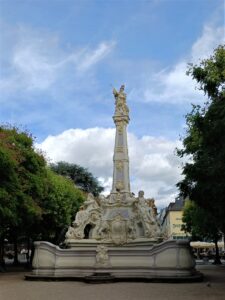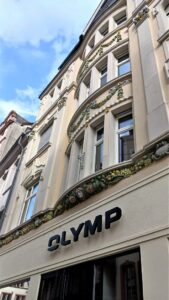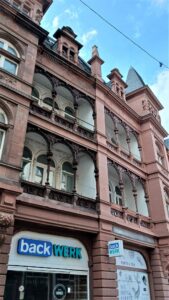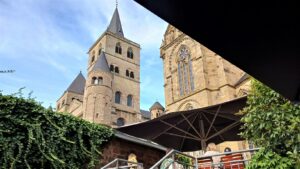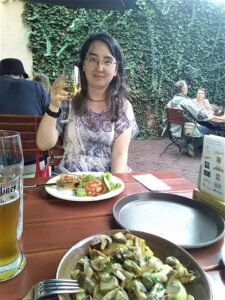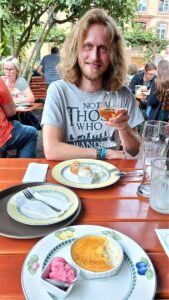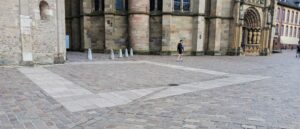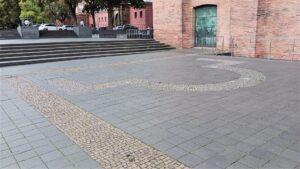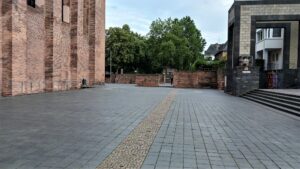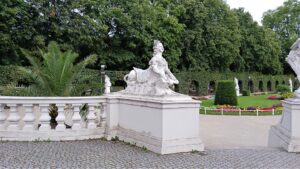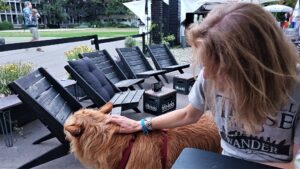Sorry I’m slowing down on these, I’m running a bit out of steam on them (and I still have three more to do T_T ) (why did I take so many pictures) (help)
Day 11
Trier was one of my favourite places on this trip! There’s so much to see there, but it’s all so close together. The train trip here was nice though I was sleepy. It doesn’t stick to the riverbank as easily as it did lower down on the river, I guess the river was too wiggly here for that to be cost-effective so there were a lot more bridges and long tunnels than the previous trip from Koblenz to Cochem. When we arrived it was still like 11am, too early to go to our hotel, so we decided to put our luggage in a train station locker and go to a museum first. But we needed change for the locker, so we went to the bakery in the train station and bought some buns to get the coins necessary. This accomplished, we walked to the Rheinisches Landesmuseum Trier, passing through an 18th century garden on the way. We stopped by the ornamental pond to eat lunch, and watched the ducks and pigeons faffing about.
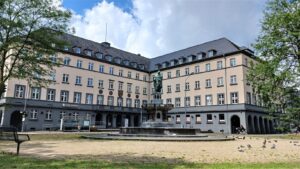
Bishop Balduin (Archbishop Balduin, actually)
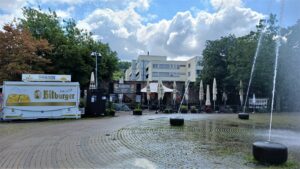
We were walking through the Palastgarten when we came across this punny place, the Queergarten! It made such an impression on us that we resolved to come back later.

The medieval city wall goes right by the Rheinisches Landesmuseum, which you can see the modern wing of in the background. There were also a couple of playgrounds near here, one for younger kids, one for older kids, both well-patroned.
The museum was great, and also bothersome. The place to buy tickets was the same place as the wardrobe lockers, which… is weird, that it’s not in the main lobby. Also nobody on staff smiled and it was really unwelcoming, in fact the lady in the front lobby practically glared at us. But Trier has this card that will allow you access to the museums and the historic Roman sites, and it’s a great deal! So we got two of those and then went to see the museum.
The museum was huge! My audio guide was not fully charged when they gave it to me and it died after like an hour, but honestly that’s fine, we would have been in there for even longer if I had spent a lot of time listening to it. After that point we kind of devolved into just looking at the stuff without trying to read about it too closely, and our feet hurt by the time we got to the end – at least mine did. It began with the earliest evidence of human habitation in the area, moving through the bronze age and Celtic artefacts, and then to Roman stuff. There was a huge hall of grave monuments, towering pillars and shrines that people erected along the main road into town that both honoured the dead person/people and glorified their family. There was a hall of religious statues. There was a hall of well-preserved floor mosaics, that was one of my favourite bits. There was definitely too much to list, and I didn’t take pictures of much because I feel that’s rude in museums (and/or some museums outright ask you not to).
It was a little weird – a lot of the Roman sculpture, especially the early stuff, was a bit off in the proportions, it looked a little amateur. But the later stuff was better, I really liked a statue that was a torso of Diana (I think? We later saw a plaster replica of the complete statue in Tübingen) (never mind, this website says it’s an Amazon: warning, contains boob). It was exquisitely detailed. There were also some lovely blown glass jars and vials. The further in history it went, the shorter the exhibits were, which is fine with me, at this point I wasn’t really interested in anything that happened after 500 years ago.
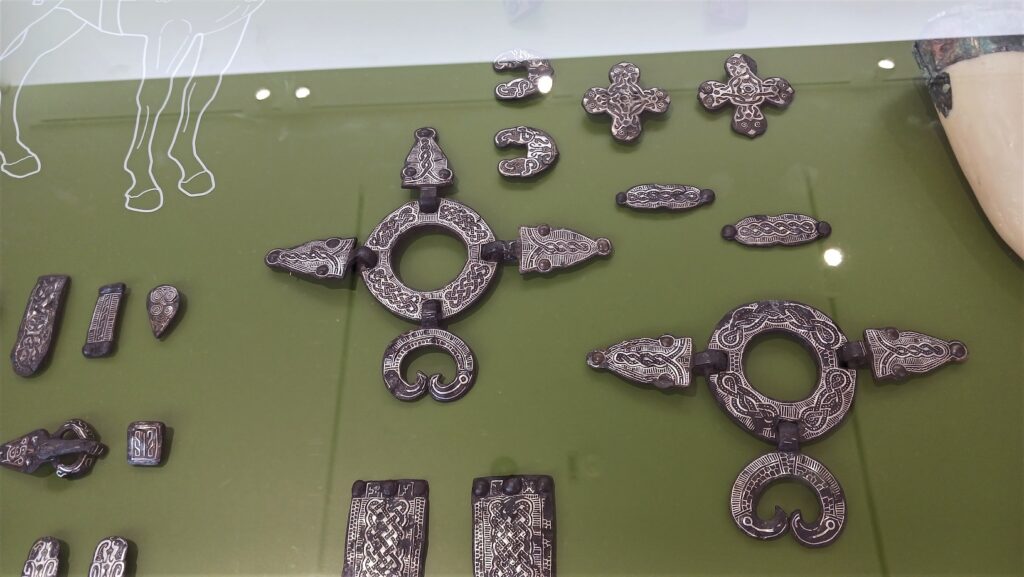
Medieval Celtic horse tack pieces; at this point we were walking very fast through what was left, and Tharash missed these and I thought he might like them. But rather than call him back and delay us further, I took a picture to show him later.
The gift shop had some neat stuff, replicas of roman coins, and a bunch of Asterix Playmobil. I saw a bunch of historic Playmobil on my journey, makes me wonder why Lego doesn’t have a mainstream historic line??
Anyway, that all took longer than we had expected, so we went back to the train station, got our stuff, and walked to our hotel which was on the exact other side of the tracks from the station. It was quite nice, had some fun character, though they didn’t have a minifridge for our cucumber and cheese, or a kettle for heating water for tea. Also the soap in the bathroom came in these weird squeezebottles which meant I always got too much when washing my hands. What’s wrong with pump bottles? The doors had a keycode, so no worries about forgetting a key of any kind. We talked with Yllamse for a bit, telling her what we’d seen that day, and looked on the internet for a place to have dinner. Again there was an issue with places that said they were open on the internet and were definitely closed in real life, but we eventually went back to the Queergarten and had fries similar to the ones we had in Aachen. Maybe not as good, but they’re not specializing in food so it’s fine. And I had another rhubarb pop.
We went for a walk through the old city to get a feel for it, and saw how close everything is, it’s seriously very compact, a great place for tourism on foot. We went to an ice cream place, but the spaghettieis (recommended to us by Yllamse) looked a bit big so we just had ice cream cones. We were caught in a sudden rain shower near the Cathedral, and we hid under a tree, though that soaked through quite quickly. I giggled half the time, especially when a big drop would collect on the tree leaves and splash down the back of my neck. XD
But I was quickly realizing just how huge Roman architecture is!
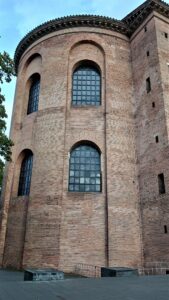
Constantine Basilica! One of the few historic places we didn’t go into on this visit. It’s weird how the Electoral Palace is built into it. Not symmetrical at all, just kind of jammed on there.
Day 12
This day was Sunday, so we were greeted by a cacophony of church bells when we opened the window. We had decided to get the hotel breakfast, because it was only like €10 (not €24 like that other place) and it was pretty good, I should have eaten more of it. There was prosciutto among the breakfast meats! I just wasn’t quite comfortable among so many people close together.
The first place we went was to hike pretty much directly south up a hill to the Ampitheatre. I got a little confused with how the gates (vomitoriums) worked, I thought regular people would enter through the arena entrance for some reason. The basement still exists, which is super cool, and it reminded us of cave levels from things like Tomb Raider or Assassin’s Creed. It was really interesting that the Romans chose to build the ampitheatre into their city wall. Or their city wall over their ampitheatre. Also at each of the historic sites you get a tiny handout that unfolds into a decent sized map containing a short description of the site’s history and notable aspects. That’s in addition to the signs around the area offering even more information.
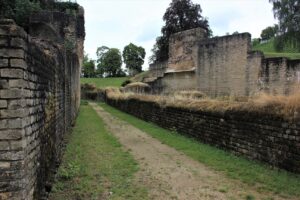
It’s called a vomitorium because it would disgorge people after a show with great rapidity. Still not a great name imo. Photo by MH
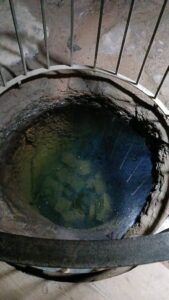
I think this hole was once the base of the machinery used for elevating things into the arena. I started imagining playing a rock concert here in 150CE, rising into an arena of screaming fans the way rock concerts happen today. : D
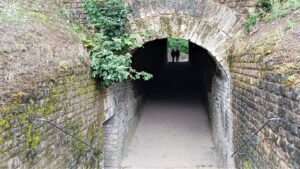
From the exit into the stands; you can see the passage from the arena on the left, and straight ahead would lead into the city.
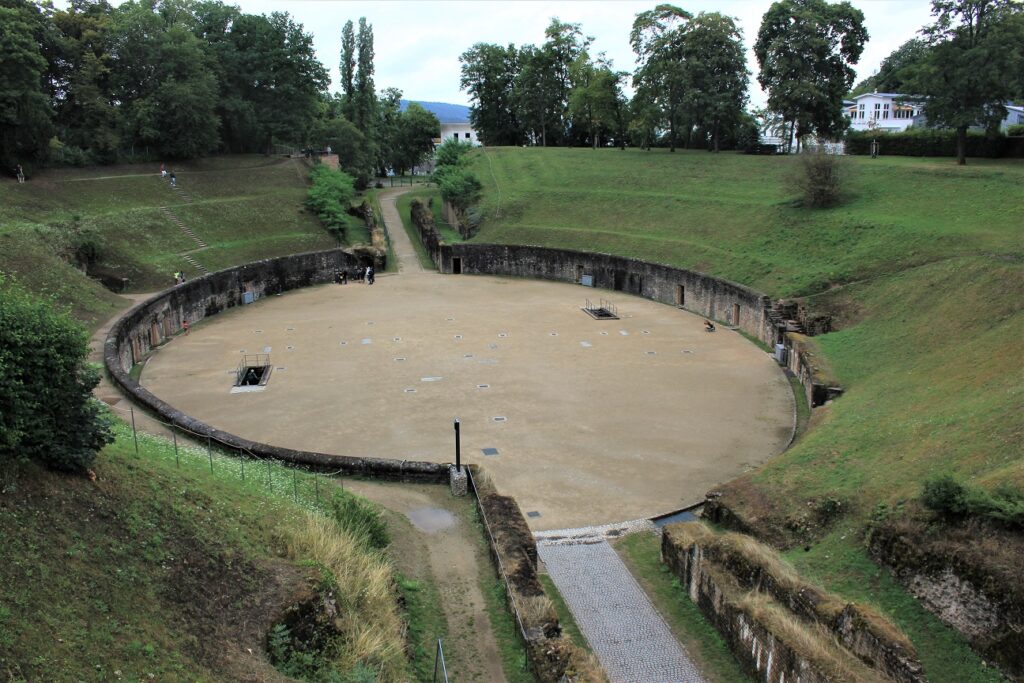
On the bottom left you can see one of the semi-circular structures the Romans used to brace the hillside against the weight of the stands. We laughed over the idea of the Romans using their arches for literally everything, sideways as well as upright. Photo by MH
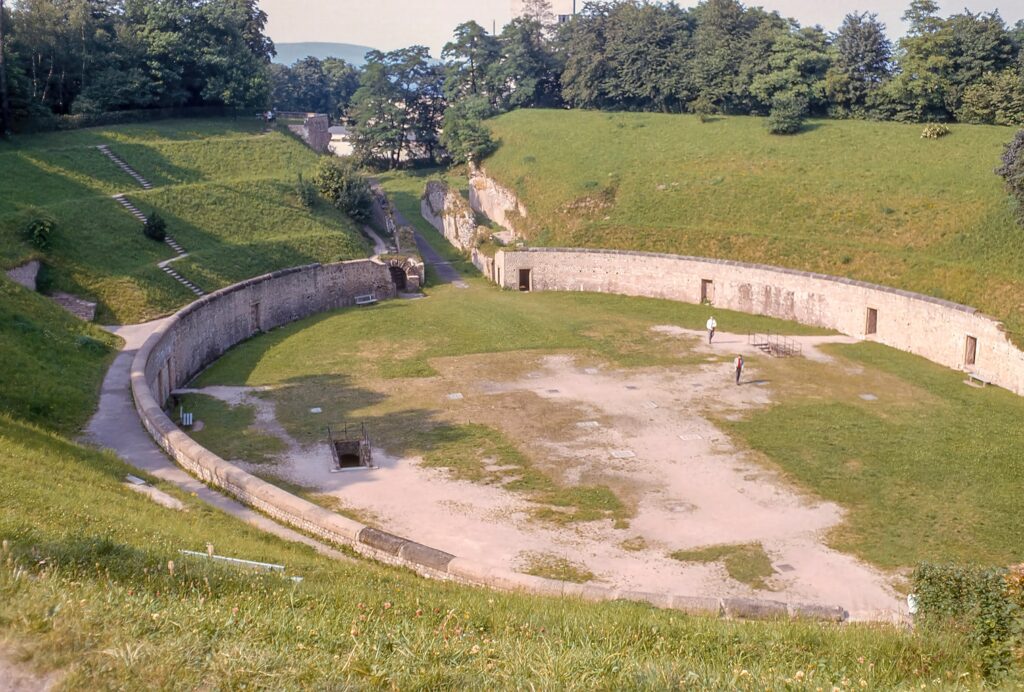
My mom’s family was here in 1966. Pretty cool how you can see the outline of the basement! Other than the grass it has not changed much! Photo by RV
Then we walked down the hill to the Kaiserthermen, the Imperial Baths. The big arch structures are pretty cool! You can see them from so far away. Their history is fascinating. It was going to be the biggest bath ever, and then it got downgraded to not as big, and then the project stalled and was finished as a barracks, and then in the Middle Ages the big windows got filled in and it was used as a castle to which the city wall ran, and then it got bombed in WWII and that revealed to people the extent of the Roman facilities, especially the underground service tunnels which is even cooler than the standing parts to me. So it has been preserved with an eye for the earliest function we know of, which is the bath part, and they had many signs about the original construction methods and the difficulties of conservation.
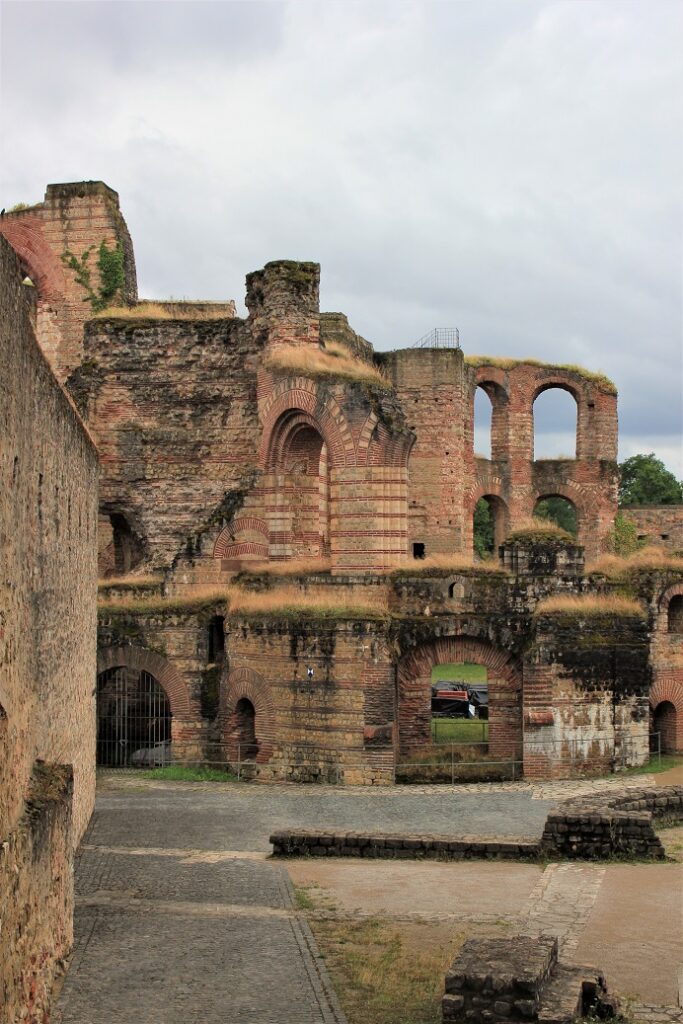
Picture taking from just outside the museum grounds, haha. We learned that the plants growing on top of the ruins may be there on purpose, to absorb moisture before it gets into the masonry. Photo by MH
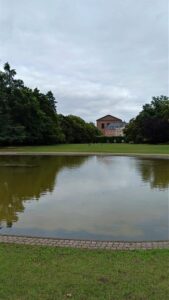
Everything’s so close together in this town; you can see the Basilica/Electoral Palace just over there.
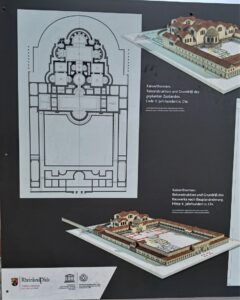
It was originally planned to be absolutely colossal, but after some issues and a pause in building, they settled for just very large.
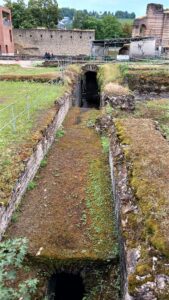
I didn’t realize yet you could go into the tunnels, but this is one end of them. You can see the stairs at the far end, which is where we ended up coming out.
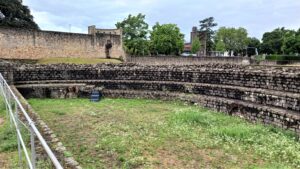
This was labelled ‘piscina’, or just pool. I guess, with its proximity to the yard, it was for exercise more than bathing?
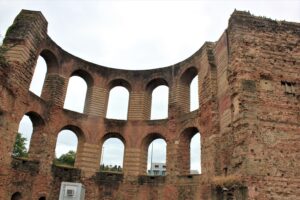
According to a photo I saw on Wikipedia, it seems that some of these arches got rebuilt in the ’80s. Still impressive that that much survived. Photo by MH
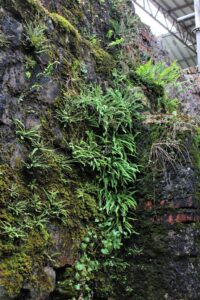
It looks pretty but this is the kind of plant growth that’s causing damage to the masonry instead of protecting it. Photo by MH
Some of the service tunnels are pitch black – I’m not sure if they’re supposed to be, or if their overhead lights weren’t working that day. I think it’s way cooler if the ceiling lights are off, personally, but that’s just me. Tharash actually scared someone by staying very still trying to line up a photograph and then the person almost bumped into him in the darkness. There was a lot of cellphone flashlight usage. (Is it bad I think it would be really cool to have a lasertag fight in a place like that?)
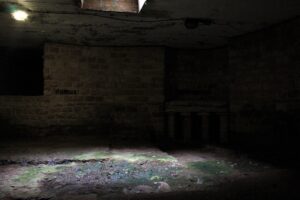
If I understood correctly, this chamber was not originally part of the baths but was under someone’s house which was torn down when the baths were constructed. There’s a bit of raised heated flooring in the corner. Photo by MH
There’s a lookout point and I heard people talking Japanese there! I don’t always turn on my ears when I’m abroad because I assume I’m not going to understand anything that’s not English, but it’s neat to hear so many different languages all at once, too.
Next we walked to the Thermen am Viehmarkt (Cattle Market Baths), which Tharash had hoped would be like the archaeological site in Aachen. And technically it was, an exposed dig under a glass pavilion, except it was huge and you could go inside, but I was a little frustrated by this place because I was trying to figure out how it would have worked when it was all put together and not a ruin, and I really couldn’t. I couldn’t tell water basins and baths apart from rooms and roads, it all just looked like random walls to me. And where was the ground level back in Roman times?? We had to go down quite a few stairs to get to the bottom, certainly not where the ground level is now! There was signage, of course, because it’s Germany, but I found it difficult to tell what structures the signs were indicating. And of course, because there were at least two well-shaped cisterns, people had been chucking coins in. People in this area just seemed to believe that any inaccessible place could be used as a wishing well, I have seen coins in all kinds of places. : P
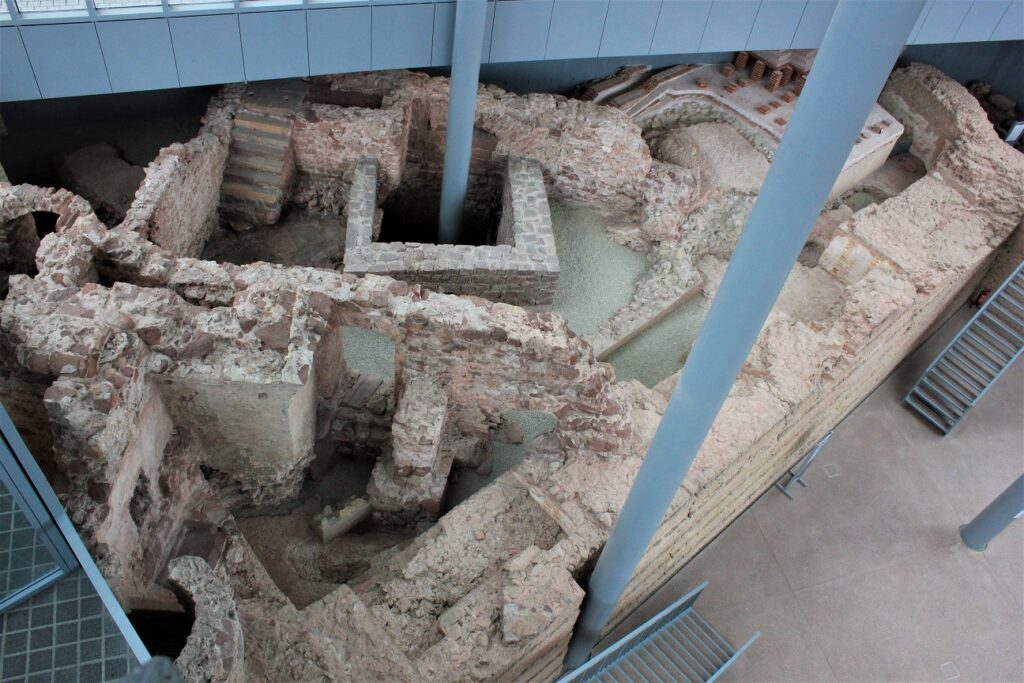
This thermen also had a viewpoint tower. At the very top you can see where the outside ground level is. Doesn’t it seem like a long way down to the old ground level? Did they build down for this one? Some raised heated flooring reconstruction is visible on the top right behind the pillar. It’s kind of neat to think that it was just as much a luxury then as in the modern day. Photo by MH
I did learn a little bit at the start, that in the Classical period a new building was built where the baths had once stood, a Cappucin monastery, but the only part that had been preserved was the part that was built on top of the ruins. I’m not sure why. It actually got demolished surprisingly late (1811 according to Wikipedia) and the land turned into a market, from which the location gets its current name.
After that I needed lunch. Tharash was a little antsy because the Cathedral would only be open for tourists for another 90 minutes, but there was no way I was going to enjoy it on an empty stomach. So we found a little bakery café and I had an avocado bagel, and Tharash had an avocado panini. It didn’t take that long to eat, and we still had plenty of time to go inside the Cathedral and its accompanying Liebfrauen Kirche and cloister walk.
The Cathedral is a very strange place. You can sense the Romanness in every part of the architecture, but it’s been renovated over the centuries to have massively ostentatious Baroque and Classical sculpture. I loved the organ, of course, but the rest of it was actually too showy? It really clashed with the austere, powerful Roman design. I do appreciate the incredible craftsmanship, of course.
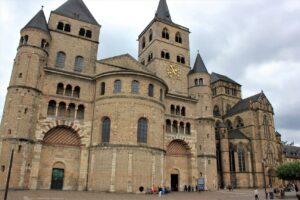
The clock says in Latin: “You do not know the hour of the coming of the Lord” or something like that, probably less flowery. Photo by MH
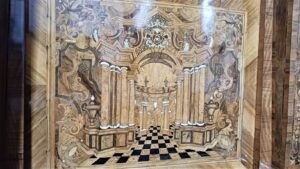
All around the half-dome here were these marquetry panels, and every one was different (though I guess it’s just as easy to make them all different as the same) – isn’t this too much effort that most people won’t take in? They’re going to be too busy looking up!
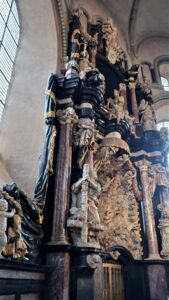
I wish there was a verb for ostentation. This altar backdrop is ostentationing all over the place. I like the black marble drapes though. Apparently there’s a relic in the chapel behind it.
The Church was smaller and more intimate, and despite the windows being very modern it actually felt more comfortable to take pictures of it.
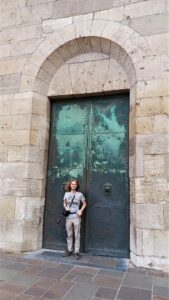
Cathedral door; Tharash for scale. Though I feel like it doesn’t get across the monumental feeling it gives in person.
We made a reservation at a restaurant right across from the Church, and then went to hang out for the rest of the afternoon. We walked by a store that was selling bins full of vintage documents, like maps from the 19th century, which was pretty cool. Then we headed down the street and rested our feet by getting some really nice chai from a random café; expensive, but tasty. We sat outside in the sun. On the table next to us someone had had a coffee, and there were a number of bees busily trying to get into the sugar container. They were pretty cute.
Then we just walked north a tiny bit and came to the pinnacle of Trier experiences, the Porta Nigra. The history of this place is wild! I mean first of all the scale of the thing is ridiculous, the stones are massive – though it seems odd to me how unfinished they look? It has all these lumps and gaps. The other town gates were cannibalized for building materials, but what’s hilarious to me is that a holy hermit lived in a room in the gate and so religious higher-ups decided not to destroy it but to turn it into a church – so they filled in the gate and built another gate right next to it. Which is where the modern road goes today! And I think that actually worked out for the best, because now you don’t have car traffic rumbling through the structure and polluting it directly and shaking it apart. Funny how that happened. The hermit is still protecting the building today, in a way. But back to the church thing, they filled in the gates right up to the next floor, which was really high up, so they had to build a whole bunch of stairs so people could come and attend church. And then apparently there was another church on the next floor up that was just for the people in the monastery.
So then Napoleon came along with his dreams of being the new Holy Roman Emperor, and with an emphasis on the Roman part, ordered it to be unchurched and restored as best as possible to how it was before. Anyway, thank you to the holy guy (Saint Simeon, the street outside is now named for him) for living there otherwise we wouldn’t have this gorgeous piece of history today.
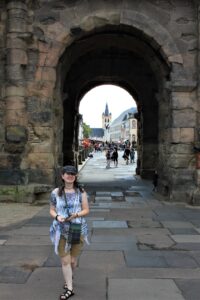
Me for scale. My hair is down for once in an attempt to protect my neck from the sun that I wasn’t expecting so much of. Photo by MH
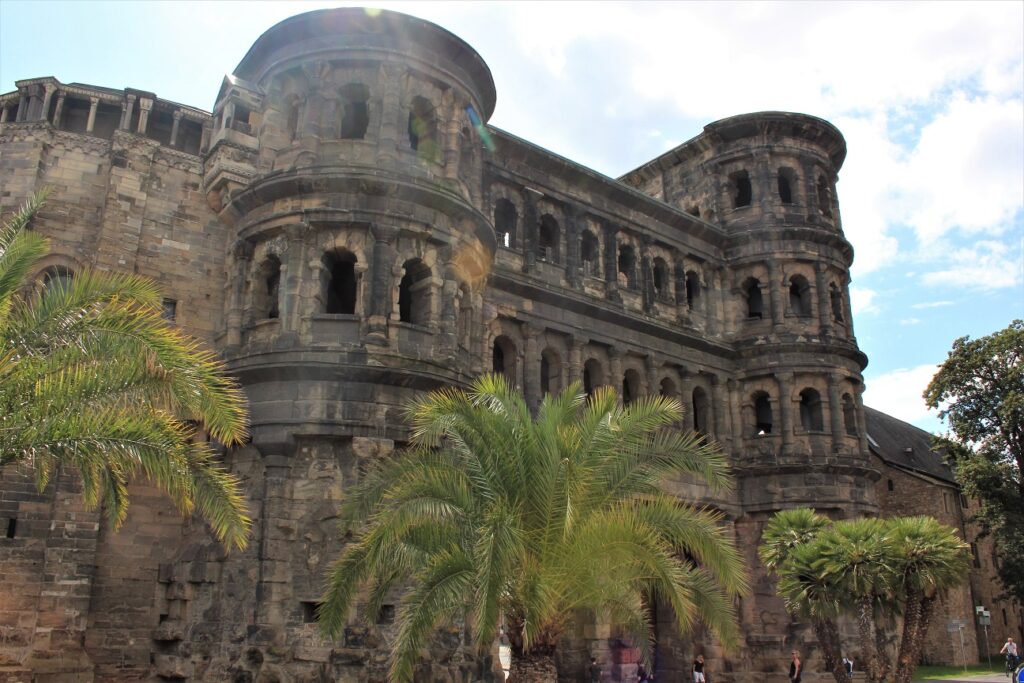
There is an official “photo point” that they suggest taking your pictures from, here it is. Photo by MH
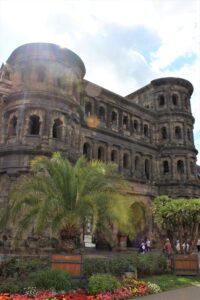
Tall version. The nice thing is that it creates a bit of an optical illusion implying that both round parts are equal height. Photo by MH
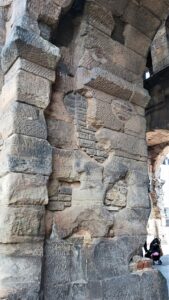
What made these holes? It seemed like every other sentence I made on this trip started with “I wonder-” but this town really brought it out in force.
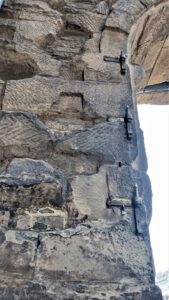
Hinges! I wonder if they’re real? It’s really difficult for me to tell what’s historical and what’s recreated, I find myself not trusting any of it. : P
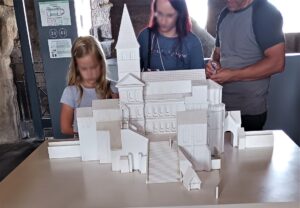
Sorry, this was the best picture I took of the church model. Come to think of it, there was one in the Rheinisches Landesmuseum too, much bigger though. But that was at the end when we were tired. It’s so funny how they made a new gate because THEY TURNED THE PERFECTLY GOOD GATE INTO A CHURCH. Also that’s a lotta stairs to get to church.
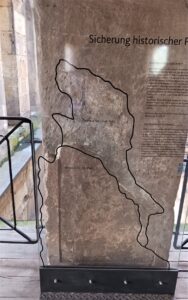
The church was plastered inside; the darker plaster is Baroque, and the lighter plaster underneath is presumed Middle Ages.
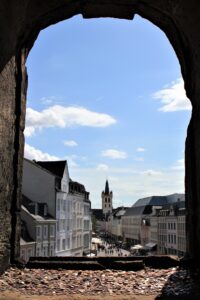
See what I mean about the wishing well syndrome? There’s a chasm between this window and the viewer. Photo by MH
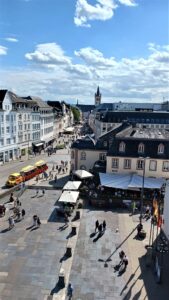
Hey, it still goes pretty straight! A lot of the medieval roads just went all spiderwebby over the old Roman grid plan, but some of the major roads partially survived.
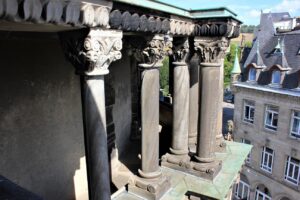
This was a bit added on to make it a church, but it was left in place to provide the remains of the Roman parts with stability (since they removed parts of the Roman structure to make room). Photo by MH

A plan of the Roman city, so you can see how close everything is! The ampitheatre is at the top, the Kaiserthermen are in the middle, at the bottom next to the bridge are the Barbarathermen where we didn’t go, and you can also see the Basilica and the future Cathedral.
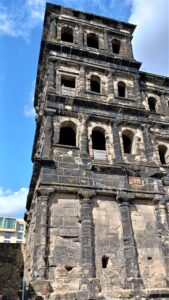
You can clearly see the two church entrances (boarded up so no one falls out). Second floor was for normal people and third floor was for religious people.
Then we walked through some of the less touristy parts of the city centre to reach the river, where there is a walking park, and we walked to the Roman bridge. We mostly chatted about DnD, little bit of inspiration for our ongoing campaign. Also this was the only day on the trip that I got sunburned, it had been cloudy earlier and we forgot sunscreen. I tried to stay in the shade as much as possible so I didn’t get sunburned that bad. But it’s true that by the time I got home I did have a lovely golden tan from all the outdoors time I’d been getting, clouds or no (but we remembered to bring the mini-sunscreen on all our future walks just in case, and we were better about putting on sunscreen before walks after this).
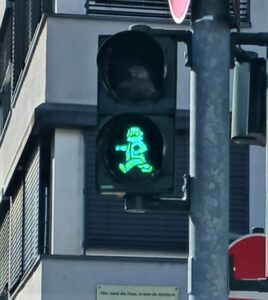
Omg I couldn’t tell that this crosswalk light was of Marx, I just saw it was different! It’s right by the statue. That’s so dang cute.
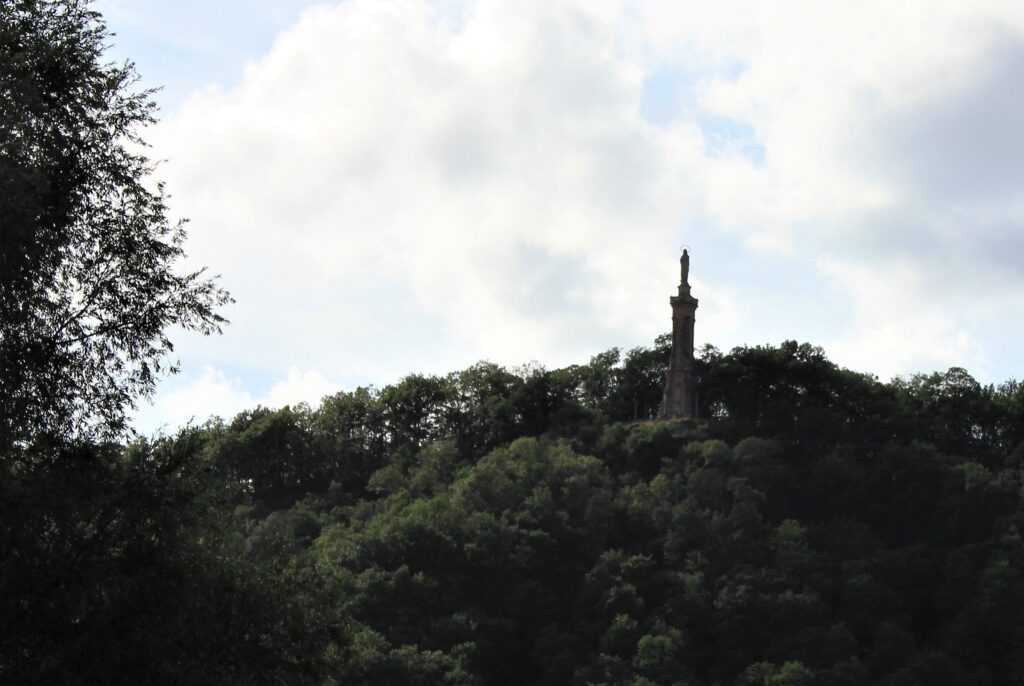
Mary’s Pillar. I’m impressed Tharash’s camera can even catch the halo of stars from this distance. Photo by MH
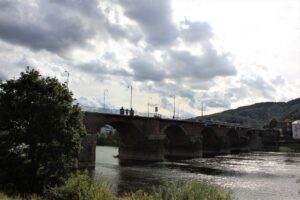
The Roman bridge! I hope it’s got some reinforcing to deal with 20th century traffic without suffering degradation. Photo by MH
The restaurant was kind of interesting in how it was set up. We sat outside and they brought us menus, and then I went inside to order at a counter and they gave me a tray with our drinks and cutlery, and a flag so they knew which table to bring the food to. I had a quiche Lorraine, which was delicious, and Tharash had mushrooms and potatoes; we both had salad with our meals. He had another weissbier, and I had a sweet mosel white wine of course. For dessert I had a crème brûlée which was absolutely marvellous and came with a little bit of peach sorbet, and Tharash had an apple pie with ice cream and we split a dessert wine (maybe actually too sweet? kind of syrupy). We took a walk back in the direction of the Queergarten and had fancier drinks there; a G&T for him and a Sex on the Beach for me, and we discussed how we would go about planning next year’s trip. I’ve decided it will be Scotland, and I’m in charge of organizing since he did so much work on this year’s (and I worked on last year’s).
We walked slowly back to our hotel, and there Tharash modified our plans for the next town a little bit to be a bit more chill.

I took this while waiting for the hour to strike so I could get the bells, I’d heard them several times and I love that deep hour bell.
